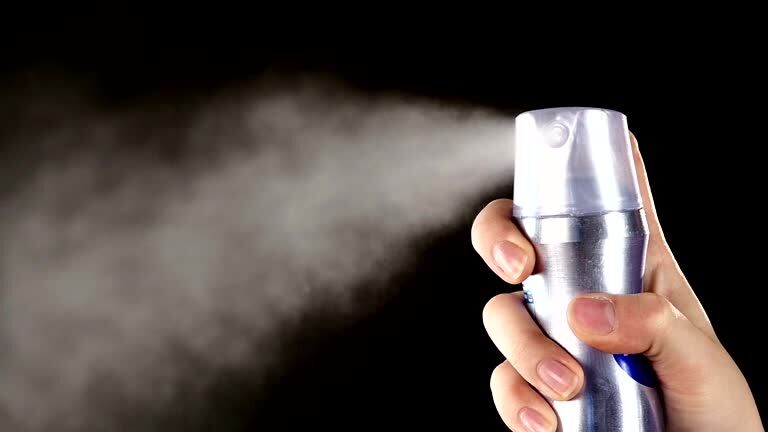Experts flag concern over commonly used Aerosol deodorants

Hyderabad: Aerosol deodorants are among the most commonly used personal care products globally.
It is being used for convenience and fast-drying applications.
But behind the ease of use lies a complex chemical profile that has raised environmental, health, and safety concerns.
Understanding the full impact of aerosol deodorants requires examining the substances they release, how they affect the body and environment, and what regulatory bodies and health experts have to say.
What Are Aerosol Deodorants?
Aerosol deodorants are pressurised products that release a spray of active ingredients using a propellant, typically a liquefied gas such as butane, propane, or isobutane.
They may contain anti-perspirant agents like aluminium salts, fragrances, and other chemicals for preservation and texture.
Unlike stick or roll-on deodorants, aerosols disperse ingredients in a fine mist, allowing quick application and absorption. However, this form of delivery introduces inhalation risks and contributes to air pollution.
1. Inhalation Risks and Respiratory Effects
The most immediate concern with aerosol deodorants is the inhalation of fine particles and volatile organic compounds (VOCs). These compounds can enter the lungs and bloodstream, especially when used in closed or poorly ventilated spaces.
Dr. Priya Sundaram, a pulmonologist speaking to NewsMeter, explains: “Short-term exposure may cause coughing, throat irritation, or asthma-like symptoms in sensitive individuals. Long-term exposure, especially in teenagers who use large amounts, could have cumulative effects on lung health.”
Aerosol sprays can also irritate people with chronic respiratory diseases like asthma or bronchitis. A 2021 study published in Environmental Health Perspectives found that indoor use of aerosols significantly increased airborne VOC concentrations, particularly in bathrooms and bedrooms with little ventilation.
2. Skin and Hormonal Disruption
Many aerosol deodorants contain fragrances, phthalates, and preservatives like parabens, which can be absorbed through the skin. These chemicals have been under scrutiny for their potential role as endocrine disruptors, substances that interfere with hormone function.
According to Dr. Meenakshi Rawal, a dermatologist, “Repeated exposure to certain synthetic fragrances or aluminium-based compounds has been linked to skin irritation and may interfere with hormone levels, particularly estrogen.”
Though definitive causal links are still being researched, the precautionary principle applies; minimizing exposure to these chemicals is advised, especially for teenagers and pregnant women.
3. Fire and Explosion Hazards
Aerosol deodorants are highly flammable due to their hydrocarbon propellants (butane, propane). There have been multiple cases of accidental fires and explosions in homes and vehicles caused by improper use or storage.
The Fire and Rescue Services have repeatedly issued warnings, stating that:
“Leaving aerosol cans in direct sunlight or near a heat source, such as in a parked car or next to stoves, can lead to explosive pressure buildup.”
In some regions, aerosols have even been misused as recreational inhalants, leading to fatalities, a phenomenon referred to as “huffing.”
4. Environmental Concerns
Though CFCs (chlorofluorocarbons) were banned decades ago due to their role in ozone depletion, modern aerosol sprays still contain hydrocarbons and compressed gases that contribute to ground-level ozone, a major component of urban smog.
The World Health Organization (WHO) has also identified VOCs from aerosols as contributors to indoor air pollution, which is responsible for over 3.8 million premature deaths annually worldwide, mostly due to respiratory diseases.
5. Impact on Waste and Recycling
Aerosol cans, even when empty, pose challenges for recycling. Because they are pressurised containers, many municipal recycling programs do not accept them or require special handling.
If punctured or incinerated, they can explode, making them hazardous in landfills and waste processing facilities. This increases the burden on already strained waste management systems, especially in countries with limited hazardous waste segregation.
6. Regulatory Oversight and Gaps
Various agencies regulate the ingredients in deodorants and the environmental safety of aerosol sprays. However, critics argue that the cumulative and interactive effects of the chemicals in aerosol deodorants are not fully understood or regulated.
In India, while the Bureau of Indian Standards (BIS) has guidelines for cosmetics, enforcement and public awareness around aerosol risks remain limited.
Safer Alternatives
Given the known concerns, experts recommend switching to non-aerosol alternatives, such as:
• Stick or roll-on deodorants (preferably with fewer synthetic additives)
• Cream deodorants made with natural ingredients
• Crystal deodorants (potassium alum-based)
• DIY deodorants using baking soda, coconut oil, and essential oils
While these may not offer the same convenience as aerosols, they significantly reduce inhalation and environmental risks.
Conclusion
Aerosol deodorants, though widely used, come with a range of health, environmental, and safety concerns that are often overlooked. From indoor air pollution and fire hazards to long-term hormonal and respiratory effects, the cumulative risks call for greater awareness and regulation. With increasing evidence pointing to their harmful effects, switching to safer, non-aerosol options is not only a personal health choice but an environmental responsibility.
As Dr. Priya Sundaram aptly puts it, “The air we breathe indoors is just as important as what we put on our skin. We must start connecting the dots between daily habits and long-term health.”
Source link

